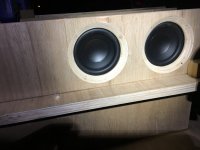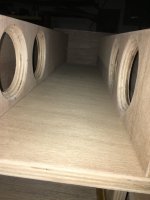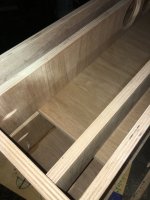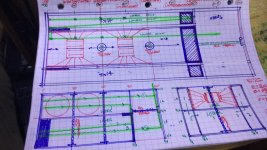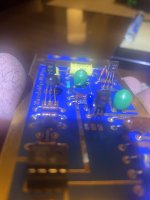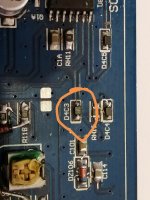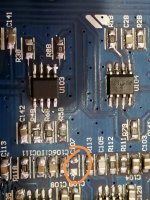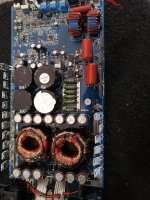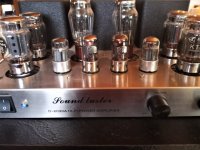Long backstory read if you want to know why I'm doing this experiment.
I’ve been watching PS Audio’s Paul McGowan’s videos for some time now and have seen bits and parts of the development of the current FR30 speakers. It turns out they are basically using a BG Neo 10 for the midrange and Neo 3 for the tweeter. This is interesting because there are currently some similar drivers available for purchase at parts express under GRS that are relatively cheap compared to their BG counterparts. I’d like to build a similar speaker that uses these planar drivers but have no idea how to construct the box since they do not have TS parameters like conventional drivers. These are some experiments that I’ve done to try and learn about optimal box size.
Testing Setup
A basic test enclosure was built using some scrap wood lying around and was used to experiment with box volume to see how it affects the parameters above. The size of the box is somewhat random, and there is no real reason for its initial size and volume aside from a shape that I would reasonably expect to incorporate into a completed speaker.
It measures 5” x 10” x 12”, and the driver is mounted in the front with a foam gasket to prevent air leaks.
To adjust the size of the box, I have a panel with a foam gasket parallel to the driver that can shift forwards and backward to adjust the internal volume.
All measurements were taken from 1 Meter away, at a fixed volume using REW, and then 1/12 smoothing was applied to FR graphs. (Just to make it a bit easier to read without losing too much detail)
Baseline Test: Full Volume
No internal Wall, internal Volume of 600" cubed
Frequency Response
The frequency response of the driver in the box with full volume doesn't look great. There are two large peaks in the 900-2khz region that can cause sounds to be shrill.
Distortion
Since this is a planar driver, distortion values were quite low. In the usable range from 300hz to 6khz, the THD is below 1% at its highest and there is no audible distortion past 500hz
Waterfall Plot
Also as expected of a planar driver, the decay time is very fast. No real issues with stored energy here. We do once again get to see the large volume peaks at 900hz and 2khz.
3/4 Volume
The box now has an internal volume of 450" cubed.
Frequency Response
Compared to the previous enclosure with full volume, this has a slightly more linear response.
Distortion
The total harmonic distortion appears to be lower than the full volume by 0.3% on average across the useful range from 300hz to 6khz.
Waterfall Plot
I am not able to see any outstanding differences in the stored energy. the planar drivers are still just as fast as with the full volume.
1/2 Volume
The box now has an internal volume of 300" cubed.
Frequency Response
Reducing the enclosure size seems to once again have smoothed out the response very slightly. Some of the dips around 1.4khz have filled in and some of the smaller peaks above 3khz have been reduced.
Distortion
The total harmonic distortion does not seem to have any significant differences compared to the 75% volume measurement.
Once again no significant differences to the waterfall plot.
1/4 Volume
The box now has an internal volume of 150" cubed.
Frequency Response
Compared to the box with half volume, the quarter volume box seems to have a few deeper dips and higher peaks.
Distortion
The total harmonic distortion has increased by about 1% across the usable frequency range from 300hz to 6khz compared to the box with 1/2 Volume.
Waterfall Plot
There's a pattern, nothing to see here.
Minimum Volume
The divider board was pushed as close to the back of the driver as possible. Not sure exactly what the volume is, but there is barely any space behind the driver.
Frequency Response
The response for the minimum volume is quite interesting. It appears that across the usable spectrum the response is the flattest out of all of the previous measurements. However, there is a steep rise in SPL at around 800hz. One could speculate that due to the small width of the baffle, the increased volume after 800hz is a result of baffle gain. IT could also be a result of other causes.
Distortion
While the response of the box and driver has become more linear, the total harmonic distortion has increased in a few areas. The total harmonic distortion increased significantly between 300hz to 700hz giving an average of 3%, while the remainder of the frequency range kept a fairly low average of 0.3% THD. These problem areas may be a result of having a hard surface parallel to the driver and also being so close to the driver. the back wave of the driver may be bouncing back and affecting the sound produced by the front of the driver. if you have other theories on why this may be the case, feel free to let me know.
Waterfall Plot
Still no appreciable differences.
Conclusions
The smoothest frequency response across the entire frequency range was produced by the box with of 300" cubed volume. The best distortion characteristics were also exhibited by the 1/2 Volume box. However, in the upper frequencies beyond 800hz the minimum volume box performed best. The box with minimum volume had some strange interactions and produced both the highest distortion values and lowest distortion values, perhaps other methods of damping the box may help to solve those issues and make it a viable option. In terms of the waterfall plots or stored energy, in each scenario, the drivers seem to have no issues staying fast, and dissipating energy instead of ringing.
Maybe in the next experiment, I'll play around with stuffing the box with various materials to see how they affect the driver's response characteristics. Currently, the materials I plan on testing are Polyfill, Rockwool insulation, Felt, and Melamine Foam.
PS.
First time making a post on DIY Audio, and a very new speaker builder. There are a lot of things that I don’t fully understand yet and I’m doing my best to explore and learn. If anything I’ve written is misinformation or conducted improperly, please feel free to let me know, I’d love to get as much input and feedback as possible. I’m still pretty new in the audio space and as such, can’t say that my ears are trained and skilled at picking out nuances like other audiophiles might be able to. That’s why this post is only going to contain objective measurement information. I’m sure subjective testing is very important as well, but I don’t think I can do a good job of that as of now.

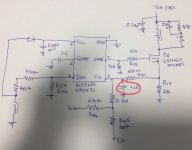
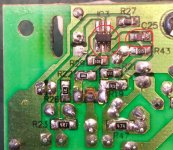



 Adapter board next to standard op-amp. Note that the dimensions are 12.8mm x 12mm.
Adapter board next to standard op-amp. Note that the dimensions are 12.8mm x 12mm.  Installed in a phono preamp.
Installed in a phono preamp.
 Schematic
Schematic
















